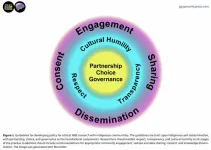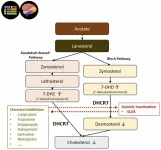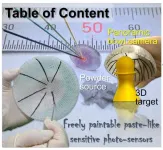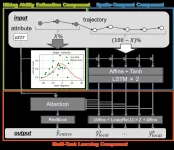(Press-News.org) HOUSTON ― Researchers at The University of Texas MD Anderson Cancer Center have developed a novel antibody-toxin conjugate (ATC) designed to stimulate immune-mediated eradication of tumors. According to preclinical results published today in Nature Cancer, the new approach combined the benefits of more well-known antibody-drug conjugates (ADCs) with those of immunotherapies.
ADCs have emerged as a breakthrough in recent years due to their modular design, which enables precise delivery of therapies to tumors by targeting specific proteins expressed on cancer cells. These conjugates use their tumor-targeting ability to deliver a payload, usually a chemotherapy, directly to the cancer cells, resulting in their destruction.
According to corresponding author Wen Jiang, M.D., Ph.D., associate professor of Radiation Oncology, the ATC differs in that it’s not designed to kill the cancer cells directly.
“Effective ADCs are designed to destroy tumor cells, but they often do so incompletely, leading to resistance and recurrence,” Jiang said. “With this new ATC approach, we aim to trigger the body’s natural immune response. This should not only limit side effects but also allow the immune system to attack tumors throughout the body and potentially prevent their recurrence.”
Many solid tumors express the CD47 protein on their surface, which serves as a “don’t eat me” signal to the body’s immune system, allowing the tumor to evade detection. The antibody in this ATC targets CD47, but instead of delivering a chemotherapy payload to destroy the tumor, it delivers a bacterial toxin.
Simplified, the CD47 antibody binds to cancer cells, marking them to be eaten by the body’s immune cells. Once the immune cells engulf the tumor, the toxin is released inside, becoming activated and creating pathways that allow tumor DNA and protein fragments, which are usually destroyed, to escape. These materials are then processed to help the immune cell better recognize and mount its own antitumor defense.
“This design was inspired by bacteria, which have an incredible ability to escape from cells’ internal traps, multiply and spread, all while keeping the host cell alive and functional,” Jiang said. “We’re harnessing that same ability to shuttle intact tumor material to the right places within immune cells. Instead of being destroyed, the tumor material teaches the body to better recognize tumor cells.”
In preclinical models of breast cancer and melanoma, this approach demonstrated multiple benefits. By educating the immune system to recognize unique signatures of cancer cells that distinguish them from normal tissues, the new ATC was more effective at triggering an antitumor immune response. This allowed immune cells to eliminate tumors throughout the body.
The T cells created by this process also remained after two months, suggesting a memory effect to this approach that could prevent tumor recurrence.
“We hope this new design opens up an entirely new avenue for research that expands the possibilities for ATCs,” said first author Benjamin Schrank, M.D., Ph.D., resident physician in Radiation Oncology. “We want to train the immune system to recognize and respond to these tumors so it can continue fighting cancer even after the treatment is completed.”
This method also has potential as to be combined with conventional therapies, especially with radiation therapy. Many solid tumors respond to radiation therapy by trying to shield themselves with proteins, including CD47. This upregulation of CD47 would make them even more susceptible to the ATC.
“This immune-stimulating ATC concept extends beyond CD47, and we are already developing projects that target other tumor-specific receptors to create ADCs that enable the body to target a wide range of difficult-to-treat cancers,” said Betty Kim, M.D., Ph.D., professor of Neurosurgery and co-lead of the study. “Our goal is to have the first of these ready for clinical testing within the next three to five years.”
This work was supported in part by the National Institutes of Health (R01NS117828, P30CA016672) and the American Cancer Society (RSG-22-052-01-IBCD, PF-24-1156745-01-ET), the Radiological Society of North America (RR1644), the SITC-Merck Cancer Immunotherapy Clinical Fellowship, and the American Society of Clinical Oncology Young Investigator Award (2024YIA-0832385427).
END
MD Anderson researchers develop novel antibody-toxin conjugate
New drug design prompts immune response rather than directly destroying cancer cells
2025-02-25
ELSE PRESS RELEASES FROM THIS DATE:
One in ten older South Asian immigrants in Canada have hypothyroidism
2025-02-25
Toronto, ON – A new study published this week in Archives of Gerontology and Geriatrics Plus found that 10% of South Asian immigrants aged 45 and older in Canada had hypothyroidism. After adjustment for a wide range of sociodemographic characteristics and health behaviors, those who had immigrated from South Asia had 77% higher odds of hypothyroidism than those born in Canada.
“To the best of our knowledge, this is the first study to identify a significantly higher odds of hypothyroidism among immigrants of South Asian descent,” says senior author Esme Fuller-Thomson, a Professor at Factor-Inwentash Faculty of Social Work (FIFSW) and Director ...
Substantial portion of cancer patients in early trials access drugs that are later approved
2025-02-25
A new paper in the Journal of the National Cancer Institute, published by Oxford University Press, finds that almost 20% of patients in middle-stage cancer drug trials receive treatment that eventually prove effective enough to get FDA approval. This may have important implications for drug development and clinical trial recruitment.
The development of new medications typically has three stages. In phase 1 trials, researchers assess drugs for safety and dosing (“What is the best tolerated dose for the patient?”). Phase 2 clinical trials determine whether a new drug shows signs of efficacy (“How much does the ...
New study calls for ethical framework to protect Indigenous genetic privacy in wastewater monitoring
2025-02-25
GUELPH, Ontario, Canada, 25 February 2025 – In a comprehensive peer-reviewed Perspective (review) article, researchers from the University of Guelph have outlined an urgent call for new ethical frameworks to protect Indigenous communities' genetic privacy in the growing field of wastewater surveillance. The study, published today in Genomic Psychiatry (Genomic Press New York), examines how the analysis of community wastewater – while valuable for public health monitoring – raises significant privacy concerns for Indigenous populations.
"Wastewater-based ...
Common medications may affect brain development through unexpected cholesterol disruption
2025-02-25
OMAHA, Nebraska, USA, 25 February 2025 - In a peer-reviewed Perspective (review) article, researchers at the University of Nebraska Medical Center have uncovered concerning evidence that commonly prescribed medications may interfere with crucial brain development processes by disrupting sterol biosynthesis. Their findings, published today in Brain Medicine (Genomic Press, New York), suggest that this previously overlooked mechanism could have significant implications for medication safety during pregnancy and early development.
"What we've discovered is that many prescription medications, while designed for entirely different purposes, can inadvertently interfere with the brain's ...
Laser-powered device tested on Earth could help us detect microbial fossils on Mars
2025-02-25
The first life on Earth formed four billion years ago, as microbes living in pools and seas: what if the same thing happened on Mars? If it did, how would we prove it? Scientists hoping to identify fossil evidence of ancient Martian microbial life have now found a way to test their hypothesis, proving they can detect the fossils of microbes in gypsum samples that are a close analogy to sulfate rocks on Mars.
“Our findings provide a methodological framework for detecting biosignatures in Martian sulfate minerals, potentially guiding ...
Non-destructive image sensor goes beyond bulkiness
2025-02-25
While photo-thermoelectric (PTE) sensors are potentially suitable for testing applications, such as non-destructive material-identification in ultrabroad millimeter-wave (MMW)–infrared (IR) bands, their device designs have primarily employed a single material as the channel. In general, PTE sensors combine photo-induced heating with associated thermoelectric (TE) conversion, and the employment of a single material channel regulates the utilization of devices by missing the opportunity for fully utilizing their fundamental parameters. ...
1st Japanese version of US psychological scale for esophageal symptoms
2025-02-25
Psychological factors have a greater impact on the severity of symptoms in esophageal diseases than objective evaluations, such as acid reflux and esophageal motility function. Although there are questionnaires that assess general psychological states in Japan, there were none that were specific to esophageal symptoms. In the United States, meanwhile, the Esophageal Hypervigilance and Anxiety Scale (EHAS) questionnaire that evaluates symptom-specific hypervigilance and anxiety for esophageal symptoms was developed in 2018.
In an effort to expand the use of EHAS, Dr. Akinari Sawada’s research group at Osaka Metropolitan ...
HikingTTE: a deep learning approach for hiking travel time estimation based on personal walking ability
2025-02-25
At the University of Electro-Communications, a research team led by Mizuho Asako, Yasuyuki Tahara, Akihiko Ohsuga, and Yuichi Sei has developed a new deep learning model called "HikingTTE" that significantly improves hiking travel time estimation. Hiking is popular worldwide, but accidents still occur when hikers underestimate the time needed to reach their destination.
This model could help reduce mountain accidents and improve hiker safety by providing more accurate travel time predictions. Previous hiking travel time estimation methods often use the relationship between slope (uphill or downhill) and walking speed. However, these ...
Environment nudges birds to fast, or slow, life lane
2025-02-25
Birds worldwide make strategic decisions about how they live based on their environmental conditions. Some live fast, die young, and leave as many chicks as possible. Others live long and prosper by not breeding.
A new study of non-migratory birds provides clues about how climate change may affect the long-standing evolutionary strategies of feathered friends. The work is reported in this week’s Ecology Letters and was led by Michigan State University postdoctoral fellows of the MSU Institute for Biodiversity, Ecology, Evolution, and Macrosystems (IBEEM).
The ...
The U-shaped relationship between admission peripheral oxygen saturation and all-cause hospital mortality in acute exacerbation of chronic obstructive pulmonary disease: a retrospective analysis using
2025-02-25
Highlight box
Key findings
• This study investigated the U-shaped nonlinear relationship between admission oxygen saturation (SpO2) and all-cause hospital mortality in patients with acute exacerbation of chronic obstructive pulmonary disease (AECOPD). The results showed that the lowest all-cause hospital mortality was observed at an SpO2 of 89.5%. Additionally, SpO2 was identified as an independent risk factor for predicting all-cause hospital mortality in AECOPD patients, providing valuable guidance for optimizing oxygen therapy in this population.
What is known and what is new?
• Most studies indicate that maintaining SpO2 levels between 88–92% provides ...
LAST 30 PRESS RELEASES:
University of Oklahoma researcher awarded funding to pursue AI-powered material design
Exploring how the visual system recovers following injury
Support for parents with infants at pediatric check-ups leads to better reading and math skills in elementary school
Kids’ behavioral health is a growing share of family health costs
Day & night: Cancer disrupts the brain’s natural rhythm
COVID-19 vaccination significantly reduces risk to pregnant women and baby
The role of vaccination in maternal and perinatal outcomes associated with COVID-19 in pregnancy
Mayo Clinic smartwatch system helps parents shorten and defuse children's severe tantrums early
Behavioral health spending spikes to 40% of all children’s health expenditures, nearly doubling in a decade
Digital cognitive behavioral treatment for generalized anxiety disorder
Expenditures for pediatric behavioral health care over time and estimated family financial burden
Air conditioning in nursing homes and mortality during extreme heat
The Alps to lose a record number of glaciers in the next decade
What makes a good proton conductor?
New science reporting guide published for journalists in Bulgaria
New international study reveals major survival gaps among children with cancer
New science reporting guide published for journalists in Turkey
Scientists develop a smarter mRNA therapy that knows which cells to target
Neuroanatomy-informed brain–machine hybrid intelligence for robust acoustic target detection
Eight SwRI hydrogen projects funded by ENERGYWERX
The Lundquist Institute and its start-up company Vitalex Biosciences Announces Strategic Advancement of Second-Generation fungal Vaccine VXV-01 through Phase 1 Trials under $40 Million Competitive Con
Fine particles in pollution are associated with early signs of autoimmune disease
Review article | Towards a Global Ground-Based Earth Observatory (GGBEO): Leveraging existing systems and networks
Penn and UMich create world’s smallest programmable, autonomous robots
Cleveland researchers launch first major study to address ‘hidden performance killer’ in athletes
To connect across politics, try saying what you oppose
Modulating key interaction prevents virus from entering cells
Project explores barriers to NHS career progression facing international medical graduates
Jeonbuk National University researchers explore the impact of different seasonings on the flavor perception of Doenjang soup
Two Keck Medicine of USC Hospitals named Leapfrog Top Teaching Hospitals
[Press-News.org] MD Anderson researchers develop novel antibody-toxin conjugateNew drug design prompts immune response rather than directly destroying cancer cells






